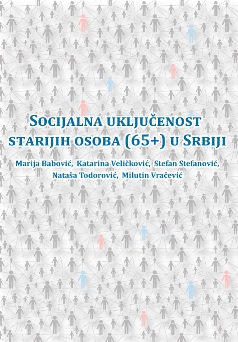Social inclusion of Older Persons (65+) in Serbia

“Social inclusion of older persons (65+) in Serbia“, the research study was done within the framework of the three year regional project “Taking Action on Social Inclusion of Older People”. The project is coordinated by the Red Cross of Serbia and supported by European Union, Austrian Development Agency and Austrian Red Cross, implemented through cooperation of civil society networks of five Western Balkans countries (Serbia, Bosnia and Herzegovina, Macedonia, Montenegro and Albania). The objective of the project is strengthening the capacities of civil society organisations and motivating older people for greater inclusion in all activities of the society.
Measuring social inclusion/ exclusion is a challenge due to its multidimensional nature as well as the absence of standardised sources of information across different countries and different vulnerable groups. Despite these limitations, the existing data allows for analysis of key aspects of inclusion/ exclusion.
The research on social inclusion of older people was based on statistical data from public sources as well as other available data, looking at financial means, access to resources and services, social participation and social networks, leisure, life styles, culture and communication, quality of life and subjective perception of satisfaction. The research activities were performed by SeCons Group for Development Initiatives. The available data shows that Serbian population is among the eldest in the world, with the trend of intensive population ageing continuing due to low natality and fertility rates and migration of younger population. Looking at the way older women and men live in Serbia, it can be said that their general status is unfavourable in comparison with the status of older persons in European Union.
According to the data, in 2016 the population over the age of 65 accounted for 19 percent of Serbian population and only 15 percent of this figure was employed. Gender differences are quite pronounced so the rate of employment for men was 19.5 percent and only 9.6 percent for women.
The results show that a significant number of older men and especially women did not have their health needs met in 2015 as well as that 8% men and 17% women over 65 do not receive any form of pension. The research also showed that it is necessary to improve the access to health services and increase the capacities for home care and home treatment of older people. A good example of improved healthcare services is introduction of electronic prescriptions. An important aspect of ageing is ensuring financial security in the older age.
Older persons account for 15 percent of social welfare beneficiaries with the most frequently used service being home care. It is necessary to expand the offer and capacity of social welfare services.
In the twelve months preceding the research, only 17 percent of persons over the age of 65 were using a computer which is significantly lower than in the European Union where for the same population the percentage is 52.
Severe material deprivation is especially frequent with older women. This is demonstrated by the fact that almost one third of older women (65+) do not own more than one pair of shoes. Older women in Serbia rarely use information technology and almost two thirds of them live in households where older persons live alone or with an older spouse. Older women live in single households more frequently than older men.
